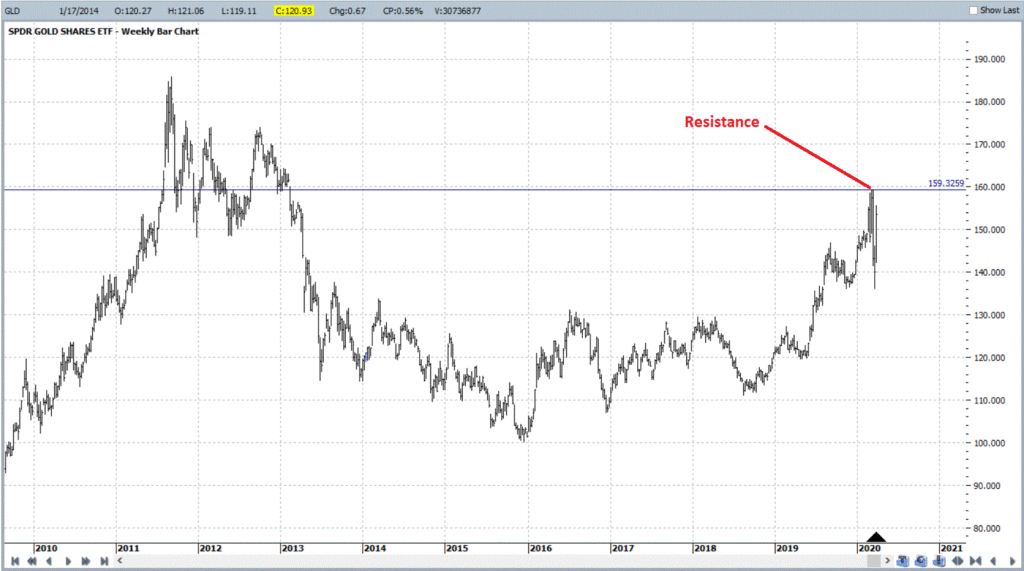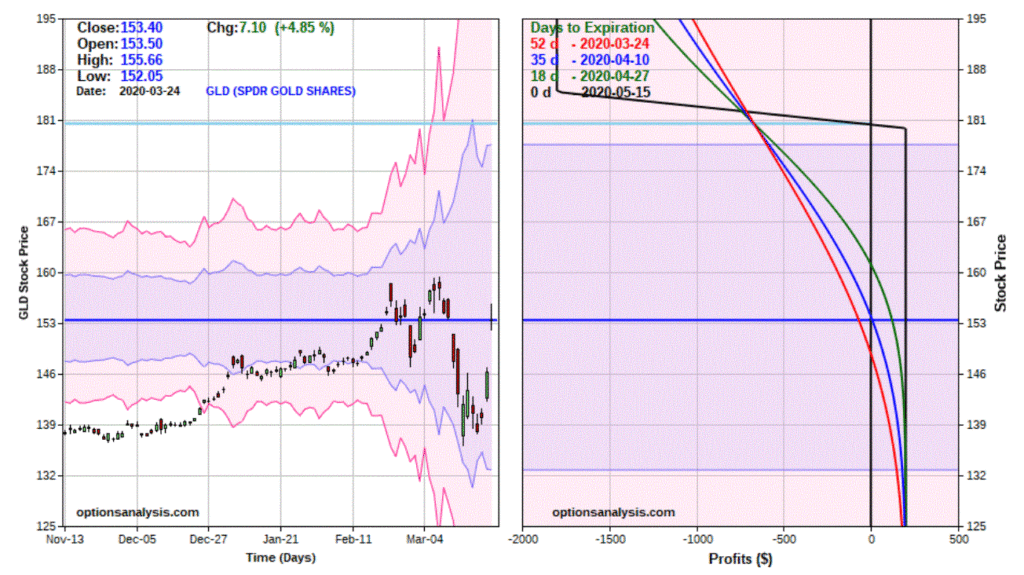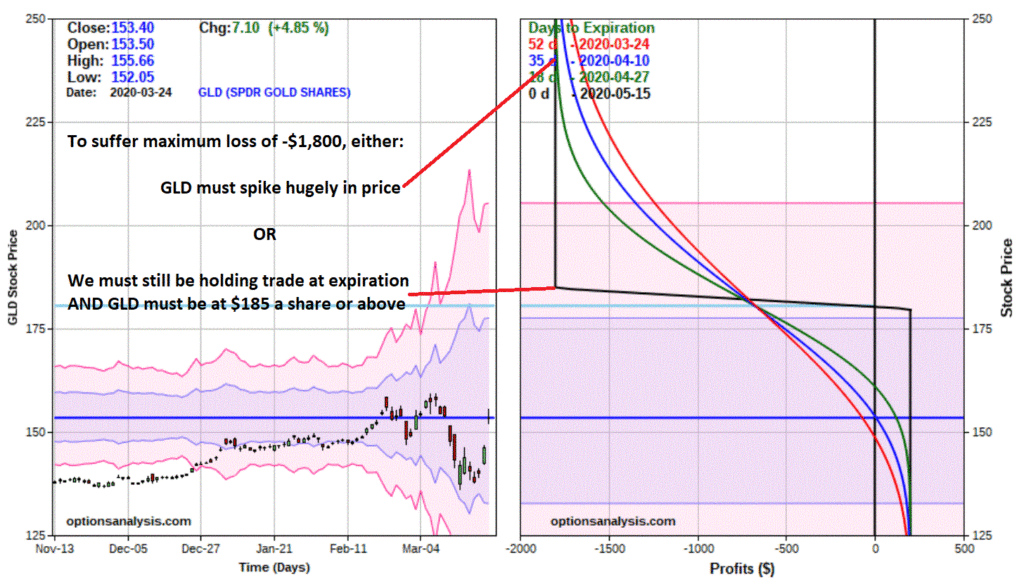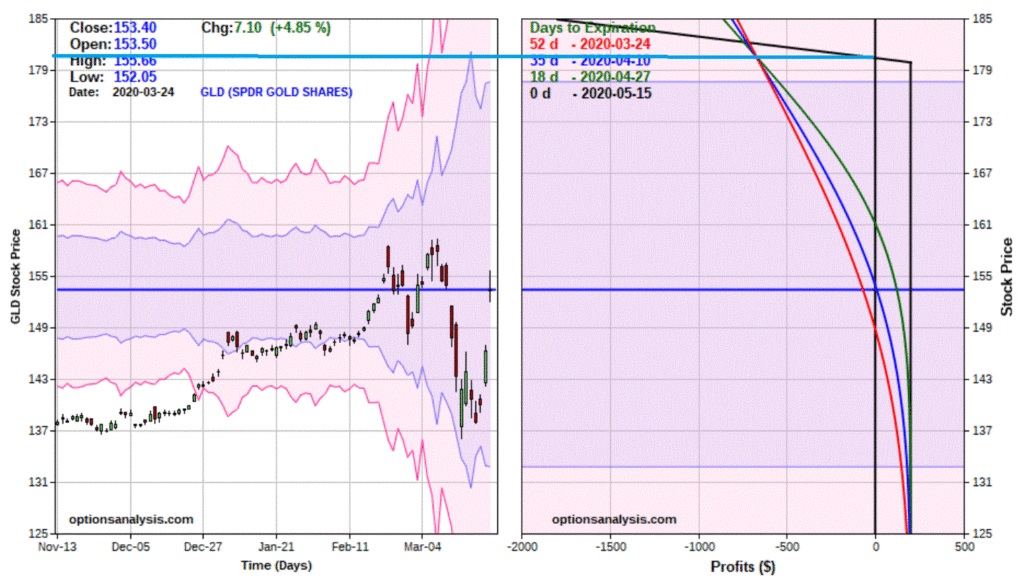The example trade discussed herein is something I started following a few days ago. Please note for the record that it is not presented as a “live trade” or as a “recommended” trade. It serves strictly as a vehicle for teaching some of the finer points of option trading.
By the way, if you have no interest whatsoever in option trading then its “Class dismissed early” for you. But thank you for checking in and please come back again soon.
A Bear Call Spread with GLD
GLD is an ETF that tracks the price of gold bullion. A bear call spread is an option strategy that can allow a trader to:
*speculate that a security will remain below a given price for a specific period of time
*take advantage of a high implied volatility situation.
Regarding the selection of GLD based on price action
In this article I wrote about an 8-year cycle for gold and noted that it was in the early stages of what is typically a bearish period. Proving once again that I actually “move markets” (unfortunately though, not in the way I intended), in the next several trading days GLD advanced almost 10% in a straight-line advance. Nevertheless, as you can see in Figure 1, GLD remained (as of 3/24 when this example trade was initiated) below the significant resistance level of 159.37.

Figure 1 – Ticker GLD; will it break out or not? (Courtesy ProfitSource by HUBB)
So, a trader might be inclined to say “can I make a trade that makes money if GLD does NOT take out that resistance level within a certain period of time?
*That is the genesis of this example – crafting a position to exploit that scenario.
*At the same time I AM NOT offering any opinion as to whether or not GLD WILL or WILL NOT take out recent resistance (besides – based on recent results – what would my opinion matter?).
Regarding the selection of GLD based on implied volatility action
In Figure 2 we can see that the implied volatility for options on GLD “spiked” during the recent price decline and relented only very slightly during the snap back rally.
IMPORTANT POINT: This high level of IV tells us that the amount of time premium built into GLD options is very high – and that it is a good time to consider selling premium rather than buying premium.

Figure 2 – GLD with implied volatility (Courtesy www.OptionsAnalysis.com)
So, based on this combination of price and volatility action we are going to consider a bear call spread that may allow us to take advantage as long as GLD does not advance significantly from here.
The Example Trade
First let’s introduce the position, then we can talk about why this position was selected and what the risk control considerations are.
The trade involves:
*Selling 4 May15 2020 180 calls @ $2.60
*Buying 4 May15 2020 185 call @ $2.10
The particulars appear in Figure 3 and the risk curves leading up to (colored lines) and at expiration (black line) appear in Figure 3a.

Figure 3 – GLD bear call spread details (Courtesy www.OptionsAnalysis.com)

Figure 3a – GLD bear call spread risk curves (Courtesy www.OptionsAnalysis.com)
Things to note:
*There are 52 days left until option expiration
*The maximum profit is $200
*The maximum risk is -$1,800
*At the time the trade is entered GLD is trading at $153.40
*The breakeven price at option expiration is $180.50
In other words, if GLD DOES NOT advance +15% between now and the middle of May, this trade will generate a profit. From a “probability” standpoint this looks like a pretty good trade. However:
*As we will discuss next, there is a big position risk management decision to be made in terms of where we would consider cutting a loss if the market goes against us.
*From a reward to risk standpoint remember that this trade ostensibly risks $1,800 in hopes of making $200 (for the record, most bear call credit and bull put credits involve taking on more risk than potential reward). But let’s address this risk first.
Regarding the Maximum Risk of -$1,800
At first blush, the idea of risking $1,800 to make $200 may not seem very appealing. But remember that option trading is primarily all about playing the probabilities AND managing risk. To illustrate, please take a close look at Figure 4 and note what has to happen in order for this trade to actually experience a loss of -$1,800.

Figure 4 – GLD bear put spread details (Courtesy: www.Optionsanalysis.com)
Two realities to note first:
*We MUST commit $1,800 of cash in our trading account in order to establish the trade
*We MUST acknowledge that it is possible that the maximum loss COULD happen and as a result we must trade in a lot-size that precludes the possibility of “catastrophic loss” (in other words, if we have a $20,000 trading account, it might be OK to trade a 4-lot but it would not be OK to trade a 40-lot)
Now, in order for us to actually lose -$1,800, either:
*Prior to expiration, GLD would have to rally from $153.40 a share to somewhere between $230 and $290 (depending on how quickly such a thing would happen). Absolutely possible, but highly unlikely.
*At expiration, a) GLD would need to be trading at $185 a share or higher, AND, b) we would still have to be holding the position.
In other words, either:
*GLD would have to essentially gap higher 50% to 90% (again, unlikely but this is why we size our trade conservatively, just in case)
*We would have to be foolish enough to still be holding the position at the time of expiration while GLD was at $180 a share or higher (in other words, we have control and the ability to NOT allow this to happen)
Position Sizing
There are no “correct” answers. Probably the most useful question is “what percentage of our capital our we willing to risk?” Let’s assume we have a $20,000 account. If we trade a 4-lot and risk $1,800, that means our worst-case loss is -9% ($1,800 divided by $20,000).
IMPORTANT POINT: For the record, if you are buying calls and puts – which can lose 100% of their value just by having the underlying remain unchanged in price – risking 9% of your trading capital on one trade is probably a little “steep” (consider that 3 losing trading in a row leaves you -27% in the hole). However, if you are selling premium and your worst case loss is very far away from the current price (like this trade), it can be OK to commit that much as long as you have some sort of plan in place to cut that loss long before it reaches the maximum level.
So, by entering a 4-lot with a $20,000 account:
*Maximum profit = $200 (11.1% of capital at risk, 1% of total account value)
*Maximum risk = $1,800 (9% of total account)
As you can see, selling premium often involves “hitting singles” rather than going for home runs as you might when buying calls and puts)
Risk Management
Now comes a crucial decision – when to actually cut a loss. And again, there are no “correct” answers, only “choices”. So here is the conundrum and the choices.
Risk Management Choice #1: Hold the trade until expiration OR until GLD hits the breakeven price of $180.50 a share, whichever comes first. This is 17.6% higher than the current price of $153.40, so from a probability standpoint the odds favor both options expiring worthless and a full $200 profit being earned.
The tradeoff is this – if GLD DOES rally to $180.50 prior to expiration the open loss is likely to be in the -$675 range.
*With this approach we are risking $675 in order to make $200 based on the hope that GLD will not rally +17.6% in the next 52 days.
Risk Management Choice #2: Exit the trade if GLD breaks out above the resistance high price of $159.37. If we set an arbitrary “trigger price” of $160 for GLD shares, our loss would be roughly anywhere from $0 to -$200, depending on how soon GLD hits $160.
The tradeoff is that there is a much greater likelihood that GLD will reach $160 than there is that GLD will reach $180.50.
*With this approach we could end up stopping ourselves out prematurely when we still had $20+ of cushion between $160 and $180.50.
Risk Management Choice #3: Something else
Figure 5 zooms in a bit on Figure 4 to better highlight the potential stop-loss points.

Figure 5 – GLD bear call spread risk curves (Courtesy www.OptionsAnalysis.com)
Assessing Probabilities
As I mentioned before, probability is a big part of option trading. According to the Probability Calculator at www.Optionsanalysis.com:
*The Probability of GLD EVER Touching $160 during the life of this trade is 77.0% (in other words, there is a high probability of getting stopped out – albeit for a very small loss – with a stop-loss at $160)
*The Probability of GLD EVER Touching $180.5 during the life of this trade is 28.5%
Bottom Line Considerations:
*The “odds” favor a stop-loss at $180.50, but this also entails greater dollar risk.
*If you are entering the trade based primarily on the belief that the resistance level will hold, it makes sense to exit the trade if that level is pierced, but you face a fairly high probability that that will be your outcome.
Decisions, decisions……
Summary
Clearly there are many factors to consider, even for a relatively simple trade. In many cases there are no clear-cut answers – you simply have to make your choices, make sure that you:
*Put the probabilities in your favor to whatever degree you can
*Utiliize intelligent position sizing (i.e., never bet the ranch)
*Utilize a thought out risk management plan and stick to it
*Do these things trade after trade after trade
Jay Kaeppel
Disclaimer: The information, opinions and ideas expressed herein are for informational and educational purposes only and are based on research conducted and presented solely by the author. The information presented does not represent the views of the author only and does not constitute a complete description of any investment service. In addition, nothing presented herein should be construed as investment advice, as an advertisement or offering of investment advisory services, or as an offer to sell or a solicitation to buy any security. The data presented herein were obtained from various third-party sources. While the data is believed to be reliable, no representation is made as to, and no responsibility, warranty or liability is accepted for the accuracy or completeness of such information. International investments are subject to additional risks such as currency fluctuations, political instability and the potential for illiquid markets. Past performance is no guarantee of future results. There is risk of loss in all trading. Back tested performance does not represent actual performance and should not be interpreted as an indication of such performance. Also, back tested performance results have certain inherent limitations and differs from actual performance because it is achieved with the benefit of hindsight.

